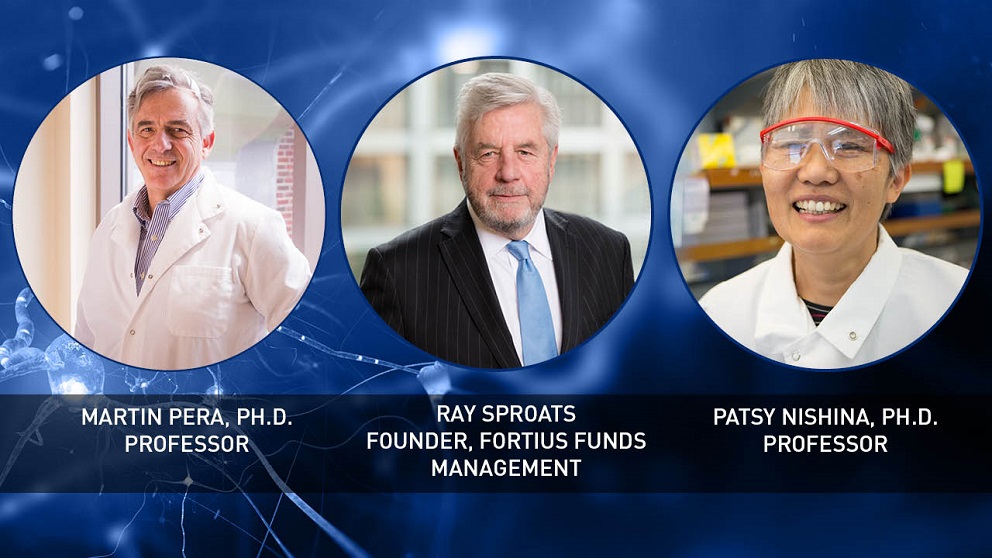
International donor’s gift will advance promising research into age-related macular degeneration.
A generous gift to The Jackson Laboratory (JAX) will support research into using human stem cells to treat age-related eye disease.
The gift from Ray Sproats, founder of the Sydney, Australia-based investment firm Fortius Funds Management, will support a three-year pilot program to test the viability of cellular therapies for age-related macular degeneration (AMD).
AMD is the most common cause of vision loss in the aging population, with an estimated 200 million cases worldwide. About 80 percent of AMD patients have the dry form of the disease, which causes blurred or reduced central vision and has no cure.
Sproats has personal motivation for supporting JAX research.
“The Jackson Laboratory has made remarkable advances in the study of ocular disease,” he said. “Having been diagnosed with AMD myself, I felt compelled to advance this research at JAX to help others suffering from AMD, with the ultimate goal of improving the treatment options for future patients.”
AMD is caused by the progressive deterioration of the retinal pigment epithelium (RPE) layer of the retina, which plays a critical role in nourishing the eye’s photoreceptors, or light-sensing cells. As the RPE deteriorates, it loses its ability to help sustain these cells, leading to photoreceptor death and vision loss.
Sproats’ gift represents a significant investment in a novel approach to the treatment of AMD, with the goal of using human stem cells to produce not only the RPE, but also the light-sensing cells that are lost in patients with the disease.
Scientists believe that replacing the damaged RPE with healthy cells holds great promise for treating AMD. In this approach, grafts made from pluripotent stem cells — laboratory-grown cells that can be directed to develop into any cell type — replace a patient’s deteriorated RPE cells. Early-stage clinical trials underway in the United States, Japan, the United Kingdom and Israel show that cell therapy for AMD is safe and that grafted cells persist in patients for more than a year.
Current strategies do not address the problem of the loss of the light-sensing cells.
JAX has a long history of leadership in using pluripotent stem cells to address human health challenges, with research that has informed discoveries in cancer, Alzheimer’s and other neurodegenerative conditions, and rare diseases.
“This generous gift will accelerate a crucial element of our mission to ease the suffering caused by human disease,” said Lon Cardon, JAX’s president and chief executive officer. “With the help of the Sproats Research Fund, JAX will be able to build on new discoveries and evaluate the results with the hope of changing the trajectory of AMD for future patients and their families.”
Cell therapy and the potential to reverse vision loss
By the time most AMD patients receive their diagnosis, they have already reached advanced stages of photoreceptor decline. Current cell therapies do not replace the lost photoreceptors, which limits the treatment’s effectiveness in reversing vision loss. Pilot studies made possible through the Sproats Research Fund will address two questions that could provide a solution for replacing the lost photoreceptors and ultimately reversing vision loss:
-
Can RPE cells be reprogrammed into light-sensing photoreceptor cells? JAX researchers routinely turn stem cells into RPE cells to investigate the genetic causes of AMD and can also build stem cell lines that contain an “on/off switch” for the eye’s master regulatory genes. Once researchers create the RPE cells from stem cells, they will test these master regulatory genes to see which ones convert the RPE into light-sensing cells.
-
Can we discover new RPE stem cells? JAX vision researchers recently discovered a type of cell in mouse RPE that has properties similar to a stem cell, which suggests it could be directed to form other types of cells. Additional testing will explore these cells to determine if they can be directed to form both RPE and light-sensing cells. If the cells can become either, the treatment would hold promise for reversing the vision loss associated with AMD.
Researchers at the forefront of discovery
The laboratories of Martin Pera, Ph.D. and Patsy Nishina, Ph.D. are collaborating on these AMD pilot studies. Pera, who came to JAX from the University of Melbourne in Australia, has two primary research focuses: identifying external factors that could allow us to control the development of stem cells into specific desired cell types, and understanding the genetic basis for individuals' different biological responses to injury in the central nervous system. Nishina investigates the genetics underlying normal retinal development and function as well as pathways leading to human eye disease. They hope their shared research will result in a demonstrated proof-of-concept that accelerates product development for use in clinical trials.
“These studies will give us a tremendous opportunity to observe stem cells in action and evaluate the results,” Pera said. “We are eager to find out how we can use that knowledge to help AMD patients.”
To learn more about supporting vision research at JAX, visit www.jax.org/give.